娃哈哈与达能商标权之争案例分析
对达能并购娃哈哈案例的分析及由此引发的思考
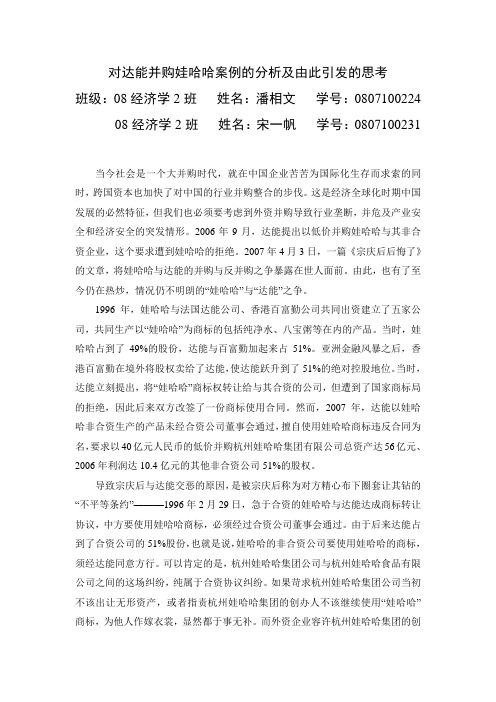
对达能并购娃哈哈案例的分析及由此引发的思考班级:08经济学2班姓名:潘相文学号:0807100224 08经济学2班姓名:宋一帆学号:0807100231当今社会是一个大并购时代,就在中国企业苦苦为国际化生存而求索的同时,跨国资本也加快了对中国的行业并购整合的步伐。
这是经济全球化时期中国发展的必然特征,但我们也必须要考虑到外资并购导致行业垄断,并危及产业安全和经济安全的突发情形。
2006年9月,达能提出以低价并购娃哈哈与其非合资企业,这个要求遭到娃哈哈的拒绝。
2007年4月3日,一篇《宗庆后后悔了》的文章,将娃哈哈与达能的并购与反并购之争暴露在世人面前。
由此,也有了至今仍在热炒,情况仍不明朗的“娃哈哈”与“达能”之争。
1996年,娃哈哈与法国达能公司、香港百富勤公司共同出资建立了五家公司,共同生产以“娃哈哈”为商标的包括纯净水、八宝粥等在内的产品。
当时,娃哈哈占到了49%的股份,达能与百富勤加起来占51%。
亚洲金融风暴之后,香港百富勤在境外将股权卖给了达能,使达能跃升到了51%的绝对控股地位。
当时,达能立刻提出,将“娃哈哈”商标权转让给与其合资的公司,但遭到了国家商标局的拒绝,因此后来双方改签了一份商标使用合同。
然而,2007年,达能以娃哈哈非合资生产的产品未经合资公司董事会通过,擅自使用娃哈哈商标违反合同为名,要求以40亿元人民币的低价并购杭州娃哈哈集团有限公司总资产达56亿元、2006年利润达10.4亿元的其他非合资公司51%的股权。
导致宗庆后与达能交恶的原因,是被宗庆后称为对方精心布下圈套让其钻的“不平等条约”———1996年2月29日,急于合资的娃哈哈与达能达成商标转让协议,中方要使用娃哈哈商标,必须经过合资公司董事会通过。
由于后来达能占到了合资公司的51%股份,也就是说,娃哈哈的非合资公司要使用娃哈哈的商标,须经达能同意方行。
可以肯定的是,杭州娃哈哈集团公司与杭州娃哈哈食品有限公司之间的这场纠纷,纯属于合资协议纠纷。
达能并购娃哈哈案例
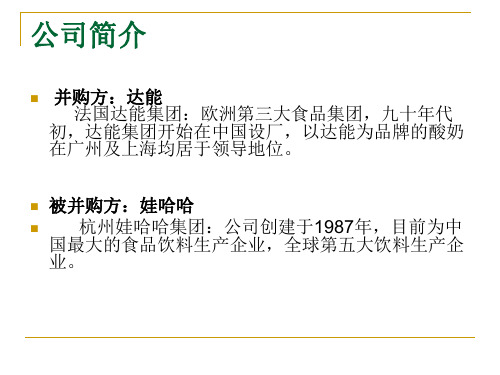
娃反 哈抗 哈达 捍能 卫低 民价 族强 品行 牌并
购
1996年,娃哈哈与达能公司、香港百富勤公司共 同出资建立5家公司,生产以"娃哈哈"为商标的包括纯 净水、八宝粥等在内的产品。
娃哈哈持股49%,亚洲金融风暴之后,百富勤将 股权卖给达能,达能跃升到51%的控股地位。
当时,达能提出将"娃哈哈"商标权转让给与其合 资公司未果后,双方改签一份商标使用合同。正是这 一条款,引发了强行收购风波。
公司简介
并购方:达能 法国达能集团:欧洲第三大食品集团,九十年代
初,达能集团开始在中国设厂,以达能为品牌的酸奶 在广州及上海均居于领导地位。
被并购方:娃哈哈 杭州娃哈哈集团:公司创建于1987年,目前为中
国最大的食品饮料生产企业,全球第五大饮料生产企 业。
达能中国二十年攻略
·1987年成立广州达能酸奶公司。 1994年与光明先后合资建立上海酸奶及保鲜乳
之后,娃哈哈集团公司又成立了公司并且将“娃
哈哈”商标用于非合资公司的生产经营上,且取得了
较好的经济效益。达能便指出娃哈哈集团公司的操作
违规,违反了10年前双方签订的协议。
2007年,法国达能公司欲强行以40亿元人民币的 低价并购杭州娃哈哈集他非合资公司5 l%的股权
2005年4月达能亚洲持有光明乳业股权,成为该公司 第三大股东。到2006年4月,增持光明股权达20.01%。
2006年7月法国达能以持股22.18%的比例成为中国汇 源集团的第二大股东。
2006年12月达能与蒙牛组建合资公司,达能持股 49%。致力于酸奶等产品的生产、研发与销售。[
事件背景
项目,达能占45.2%的股份。 1996年收购武汉东西湖啤酒54.2%的股权;
达能并购娃哈哈案例分析

汇报人: 日期:
目 录
• 背景介绍 • 并购动机与策略 • 并购过程中的关键问题 • 并购后的整合与协同 • 并购效果评价 • 案例启示与总结
01
背景介绍
达能与娃哈哈简介
达能
达能是一家全球性的食品与饮料 公司,拥有多个知名品牌,并在 多个国家和地区开展业务。
娃哈哈
娃哈哈是中国知名的食品饮料生 产企业,专注于饮料、乳品、方 便食品等多个领域,拥有众多深 受消费者喜爱的产品。
文化整合
并购后的文化整合是成功的关键,达能需要积极与娃哈哈沟通,共同 打造符合双方价值观的企业文化,避免文化冲突影响并购效果。
跨国并购的风险与挑战
法律与监管风险
跨国并购涉及不同国家的法律法规,达能需要遵守相关法 律法规,防范法律风险,同时应对监管机构的严格审查。
财务风险
跨国并购涉及大量资金流动,达能需要确保资金来源稳定 ,并进行有效的财务管理,避免财务风险影响并购进程。
市场布局调整
根据双方的市场基础和资 源优势,重新规划市场布 局,实现市场覆盖最大化 。
渠道资源整合
整合双方的渠道资源,共 享销售渠道、物流体系等 ,降低运营成本,提高市 场响应速度。
财务协同与资源配置
资金筹措与运用
通过并购实现资金筹措的规模化,降低融资成本 ,提高资金使用效率。
财务预算与控制
统一双方的财务预算与控制体系,实现财务资源 的优化配置,确保企业战略目标的实现。
娃哈哈的出售动机
资金筹措
通过出售部分股权,娃哈哈可以 获得大量资金,用于支持公司的
后续发展、投资新项目等。
引入战略投资者
达能作为国际知名企业,其入驻有 助于提升娃哈哈的企业形象,同时 引入外部战略投资者,有助于优化 公司股权结构。
娃哈哈与达能之争
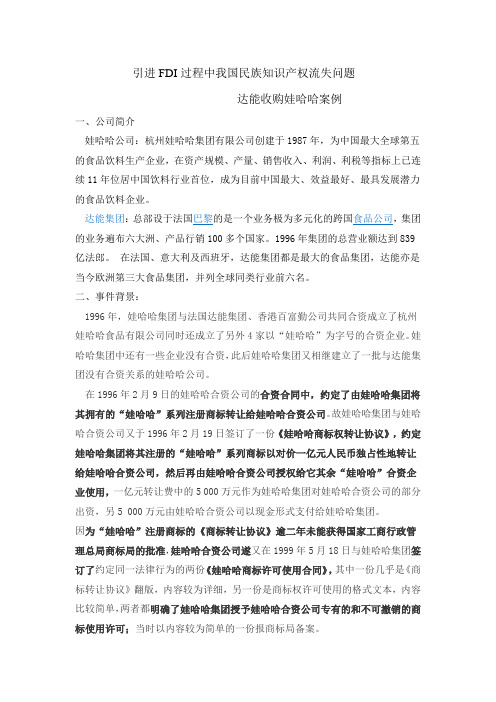
引进FDI过程中我国民族知识产权流失问题达能收购娃哈哈案例一、公司简介娃哈哈公司:杭州娃哈哈集团有限公司创建于1987年,为中国最大全球第五的食品饮料生产企业,在资产规模、产量、销售收入、利润、利税等指标上已连续11年位居中国饮料行业首位,成为目前中国最大、效益最好、最具发展潜力的食品饮料企业。
达能集团:总部设于法国巴黎的是一个业务极为多元化的跨国食品公司,集团的业务遍布六大洲、产品行销100多个国家。
1996年集团的总营业额达到839亿法郎。
在法国、意大利及西班牙,达能集团都是最大的食品集团,达能亦是当今欧洲第三大食品集团,并列全球同类行业前六名。
二、事件背景:1996年,娃哈哈集团与法国达能集团、香港百富勤公司共同合资成立了杭州娃哈哈食品有限公司同时还成立了另外4家以“娃哈哈”为字号的合资企业。
娃哈哈集团中还有一些企业没有合资,此后娃哈哈集团又相继建立了一批与达能集团没有合资关系的娃哈哈公司。
在1996年2月9日的娃哈哈合资公司的合资合同中,约定了由娃哈哈集团将其拥有的“娃哈哈”系列注册商标转让给娃哈哈合资公司。
故娃哈哈集团与娃哈哈合资公司又于1996年2月19日签订了一份《娃哈哈商标权转让协议》,约定娃哈哈集团将其注册的“娃哈哈”系列商标以对价一亿元人民币独占性地转让给娃哈哈合资公司,然后再由娃哈哈合资公司授权给它其余“娃哈哈”合资企业使用,一亿元转让费中的5 000万元作为娃哈哈集团对娃哈哈合资公司的部分出资,另5 000万元由娃哈哈合资公司以现金形式支付给娃哈哈集团。
因为“娃哈哈”注册商标的《商标转让协议》逾二年未能获得国家工商行政管理总局商标局的批准,娃哈哈合资公司遂又在1999年5月18日与娃哈哈集团签订了约定同一法律行为的两份《娃哈哈商标许可使用合同》,其中一份几乎是《商标转让协议》翻版,内容较为详细,另一份是商标权许可使用的格式文本,内容比较简单,两者都明确了娃哈哈集团授予娃哈哈合资公司专有的和不可撤销的商标使用许可;当时以内容较为简单的一份报商标局备案。
达能并购娃哈哈案例分析

xx年xx月xx日
目 录
• 达能与娃哈哈概述 • 并购事件概述 • 并购动因与交易结构分析 • 并购影响与效果分析 • 并购风险与控制措施
01
达能与娃哈哈概述
公司背景介绍
达能集团
创建于1966年,是全球著名的跨国食品和饮料公司,业务遍 及全球130多个国家和地区。
娃哈哈集团
总结词
合规性、法律诉讼
详细描述
法律风险是指由于不同国家和地区的法律法规的不同 ,以及法律法规的变化,导致并购方遭受损失的风险 。在达能并购娃哈哈案例中,法律风险主要来自于中 国的反垄断法和欧盟的反托拉斯法等法律法规的限制 和约束,以及可能面临的法律诉讼和合规成本。此外 ,法律风险还涉及到知识产权保护、商业秘密保护等 方面。
并购方式
达能以51%的股权入主娃哈哈,以现金方式支付。
并购动因与经过
并购动因
达能希望通过并购进一步开拓中国市场, 并获得娃哈哈的品牌和销售网络。
VS
并购经过
达能在1996年与娃哈哈签订了合作协议 ,共同成立了几家合资公司。2006年, 达能提出要收购娃哈哈51%的股权,遭到 娃哈哈方面的拒绝。之后,达能向法院提 起诉讼,要求撤销娃哈哈集团和娃哈哈商 标的所有权。经过一系列的谈判和协商, 双方最终达成了和解协议。
行业地位与影响
达能在中国的地位
达能在中国市场上拥有众多知名品牌,如“达能”、“碧悠”等,成为消费者喜 爱的产品。
娃哈哈在中国的地位
娃哈哈集团在中国饮料和食品市场上拥有很高的市场份额和影响力,其产品品种 丰富,覆盖面广,成为国内重要的食品生产企业之一。
02
并购事件概述
并购时间方式
并购时间
达能并购娃哈哈案例

达能并购娃哈哈一、事件背景:1996年,娃哈哈与达能公司、香港百富勤公司共同出资建立5家公司,生产以“娃哈哈”为商标的包括纯净水、八宝粥等在内的产品。
娃哈哈持股49%,亚洲金融风暴之后,百富勤将股权卖给达能,达能跃升到51%的控股地位。
当时,达能提出将“娃哈哈”商标权转让给与其合资公司未果后,双方改签一份商标使用合同。
正是这一条款,引发了强行收购风波。
二、达能&娃哈哈的婚姻历程:1996年,达能投资4300万美元与娃哈哈建立5家合资公司,达能获得51%的股权。
2007年,法国达能公司最近欲强行以40亿元人民币的低价并购杭州娃哈哈集团有限公司总资产达56亿元、2006年利润达10.4亿元的其他非合资公司51%的股权。
2007年,4月5日娃哈哈召开了董事会,认为合资合同条款不平等。
5月9日,达能亚洲及其全资子公司已经正式向瑞典斯德哥尔摩商会仲裁院提出8项仲裁申请。
其中,7项仲裁都是合资企业的外方股东针对中方股东提出的仲裁。
2007年12月-2008年4月达娃和谈,在两国政府协调下,双方中止了法律程序进行和谈。
达能要求以约200亿的价格将其投资在合资公司的不到14亿元人民币股权售给娃哈哈,价格按上市公司平均市盈率计算,被娃哈哈拒绝。
2009年9月30日,达能和娃哈哈发声明称达成和解:达能和娃哈哈集团2009年9月30日宣布,双方已达成友好和解,达能同意将其在各家达能-娃哈哈合资公司中的51%的股权出售给中方合资伙伴。
三、并购结果:失败。
失败原因:这起并购案例属于典型的恶意并购,达能公司在私底下收购了超过百分之五十的股份,且在中国大量收购龙头企业的股份,有垄断嫌疑。
达能公司实际上已经对中国的饮料业进行了垄断,严重违背了国家六部委《关于外国投资者并购境内企业的规定》中“并购方在中国的营业额超过15亿元人民币,境内资产拥有30亿元以上,境内企业超过50家,必须报经国家商务部、国家工商总局审查规定”。
娃哈哈集团&达能集团的经营战略:1、开发新产品,迅速占领市场:八十年代中后期,国民生活水平普遍提高,人们对保健意识逐渐增强。
达能并购娃哈哈案例分析ppt

行业竞争态势借鉴
行业竞争格局
达能娃哈哈所处的饮料行业竞争激烈,包 括可口可乐、百事可乐等竞争对手,这些 竞争对手的竞争态势和策略值得借鉴。
营销策略
达能和娃哈哈在营销策略上也有值得借鉴 的地方,例如娃哈哈通过与法国世界杯足 球赛的合作,提高了品牌知名度和美誉度 ,达能则通过与环保组织的合作,树立了 企业的环保形象。
企业经营策略借鉴Βιβλιοθήκη 品牌战略达能通过并购娃哈哈获得了中 国市场上的品牌影响力,但并 购后的品牌策略需要充分考虑 双方企业的特点和市场需求,
制定合理的品牌战略。
市场拓展策略
娃哈哈在中国的市场拓展策略 值得借鉴,包括建立销售网络 、开发新产品、提高产品质量
等方面的措施。
多元化战略
达能娃哈哈的多元化战略也值 得借鉴,通过多元化经营可以 降低企业风险,提高收益的稳
娃哈哈概述
娃哈哈集团
娃哈哈集团是中国最大的饮料和食品生产企业之一,创立于1989年,产品涵 盖了饮料、乳品、罐头、方便食品等多个领域。
娃哈哈品牌
娃哈哈品牌在国内拥有极高的知名度和美誉度,其产品深受广大消费者的喜 爱和信赖。
并购背景
达能希望通过并购娃哈哈进一 步扩大在中国的市场份额,提 高其在健康食品和饮料市场的
3
并购前双方合作
达能与娃哈哈在多个领域已有多年合作,如产 品代工、品牌推广等。
并购过程
01
并购动因
达能希望通过并购进一步扩大在中国 的市场份额,提高品牌影响力,并获 得更多资源。
02
并购方式
达能选择了股权收购的方式,通过购 买娃哈哈集团创始人宗庆后的股权, 获得娃哈哈集团的控股权。
03
并购历程
从最初的合作到后来的股权交易,整 个并购过程历经数年。
通过分析娃哈哈与达能的纷争

娃哈哈的反思通过分析娃哈哈与达能的纷争,提出在中外企业合资中,我国企业民族自有品牌保护意识,本土市场等问题的思考,力图探索在中国市场环境下适合双方企业合资合作的新模式。
一、事件回顾2009 年9 月30 日持续3 年的“达娃”之争,最终以达能接受娃哈哈3 亿欧元和解费同意出售在39 家合资公司里的51%的股权落幕。
纵观中外企业纠纷史,这是中方的一次难得胜利,保住了中国仅剩的不多的民族品牌,这是中国消费品业的胜利,这是东西方文化对撞冲突后,东方价值观的胜利。
这一持续3年的“达娃”之争又是怎样一步步发展的呢?1.背景:法国达能集团是总部设在巴黎的欧洲第三大食品集团,产品遍及100 多个国家。
在九十年代初开始进军中国,曾拥有乐百氏92%股权、梅林正广和50%股权、光明20.1%股权、汇源22.18%股权。
杭州娃哈哈集团是创建于1987 年的一家校办企业,二十世纪中期已经发展为中国最大的食品饮料生产企业,并且成为全球第五大饮料生产企业。
2.缘起:1996 年,娃哈哈由于在国内上市失败,急于寻觅资金,最终与达能及百富勤合资成立五家合资公司,娃哈哈集团以现有厂房、设备、土地出资占49%的股份,香港百富勤与达能以现金出资占51%,后因百富勤破产,达能成为合资公司的最大控股方。
合资公司成立之时双方在合作协议中约定,娃哈哈集团同意向合资公司转让价值为1 亿元的商标。
其中5000 万作投资,另外5000 万则向娃哈哈购买商标。
但是,这个商标转让协议不符合中国的有关法律,未能通过政府审核, 后来双方在《商标使用许可合同》中规定“: 中方将来可以使用商标在其他产品的生产和销售上,而这些产品项目已提交给娃哈哈与其合营企业的董事会进行考虑。
”接下来的几年中,娃哈哈集团先后建立了十几家与达能集团没有合资关系的非合资企业,主要生产饮料和食品,并以“娃哈哈”为商标。
3. 经过:2006 年,达能以商标使用合同中娃哈哈集团“不应许可除娃哈哈达能合资公司外的任何其他方使用商标”为由,要求收购由娃哈哈职工集资持股成立并且与达能没有合资关系的公司。
达能并购娃哈哈案例

矛盾公开前后
Company name
低价收购
宗庆后悔约
矛盾激化
达能与宗庆后达 成协议,以40亿 元收购价值56亿 元,去年盈利 10.4亿元的娃哈 哈非合资公司 51%的股权。
宗庆后通过新浪 网呼吁民众“保 护民族品牌”。 并向全国人大提 交《关于立法限 制外资通过并购 垄断我国各个行 业的提案》
2005年达能大肆收 购乐百氏却不断亏 损,因此达能提出 收购盈利的非合资 公司要求,并通过 法国政府向中国各 级政府施压
达能痛斥宗庆后违约行为
Company name
严重违约 达能对非合资公司 揭示宗庆后本质
以民族品牌自居的 宗庆后,却被媒体 发现在避税的处女 岛另外注册了集团
达能声称在2006年 调查之前,“完全 不知道宗庆后的非 法活动如此持续快 速的铺开”
达能以51:49的股权比例,形成对娃哈哈的绝对控制权
宗庆后违约
Company name
自1999年以来,宗庆后在没有得到 授权的情况下,建立了一系列使用 娃哈哈品牌的公司 在市场上直接出售与合 资公司直接竞争的产品
通过合资公司的渠道进行销售
达能集团于2007 年4月下达最后 通牒要求娃哈哈 对违约行为采取 行动,否则将进 行正式起诉。
对达能的抵触情绪
Company name
达能购买百富勤在金加的股份,这是早有预谋, 而宗庆后自称“不懂资本运作那一套游戏规则”, 因此陷入达能的圈套
达能通过通过政府施压
达能在商标使用权的相关事宜上,曾经强迫娃哈 哈签署合同
达能方面的原因
Company name
并购之初
以并购著称,只决定是否在某个 国家发展业务,对娃哈哈了解不 足 管理层完全由宗庆后控制,为以 后的“独立”埋下伏笔
娃哈哈与达能商标权之争案例分析

国际商务合同实践报告学院:管理与经济学院专业:国际经济与贸易报告人:201314513 张婷婷201314525 彭艺茹目录一.案例介绍1.1原文介绍1.2原文翻译1.3案例概述二.案例分析三.结局反思一.案例介绍1.1原文介绍:BackgroundIf you are in China,chances are you drink at least one bottle of Wahaha brand water,or perhaps the company’s iced tea,fruit drinks,or its Future Cola.If you go to the United States,you may even come cross Future Cola in New York or Los Angeles,because the company that first set up shop in an elementary school in Hangzhou,Zhejiang,is going global.The Hangzhou Wahaha Group Co.,Ltd.,China’s leading domestic beverage producer,didn’t achieve success overnight.The company’s predecessor,the Hangzhou Shangcheng District School-Run Enterprise Sales Department,funded its start-up operations in 1987 with a government loan.Zong Qinghou,the company’s founder,and two retired schoolteachers initially sold milk products and popsicles out of a school store,but to benefit the student’s health the group soon began producing and selling nutritional drinks.The company’s success selling nutrition products in school led to its first big expansion:with Hangzhou government support,the company acquired a company then changed its name to the Hangzhou Wahaha Group Co.(The word “Wahaha”is meant to mimic the sound of a baby laughing and is taken from a children’s folk song.)Wahaha’s second large-scale expansion occurred in 1994 when the company merged with three insolvent companies in Fulling,Sichuan,to set up its first factory in Chongqing.The Wahaha Joint Venture (JV)was formed in February,1996.At the start,there were three participants in the JV:Hangzhou Wahaha Food Group(Wahaha Group),led by its chairman Zong Qinghou;Danone Group,a French corporation(Danone);and Bai Fu Qin,a Hong Kong corporation(Baifu).In 1996,the two parties signed a trademark tranfer agreement,with anintention to transfer the”Wahaha”trademark to the joint ventures.The move,however,was not approved by the State Trademark Office.For this reason,the two parties signed in 1999 the trademark licensing contract.According to law,the same subject can not be synchronously transferred and licensed the use to others by the same lost.Therefore,the signing and fulfillment of the trademark licensing contract showed that the two parties had connived the invalidation of the transfer agreement.The”Wahaha”brand should belong to the Wahaha Group,while the joint ventures only have right of use.In October,2005,the two parties inked the No.1 amendment agreement to the trademark licensing contract,in which it confirmed Party A(Hangzhou Wahaha Group Co.,Ltd.)as owner of the trademark.In addition,the second provision of the amendment agreement clearly stated that the several Wahaha subsidiaries listed in the fifth annex of the licensing contract as well as other Wahaha subsidiaries(referred to as”licensed Wahaha enterprises”)established by Party A or its affiliates following the signing of the licensing contract also have right granted by one party to use the trademark.The “licensed Wahaha enterprises”involved in the amendment agreement refer to the non-joint ventures.According to related files,Wahaha owns the ownership of the “Wahaha”trademark,while its non-joint ventures have the right to use the trademark.The Danone-Wahaha Feud--Trademark LicenseFrom May,2007 when Danone initiated legal proceeding against Wahaha,the both sides have carried out several dozen lawsuits worldwide.As of May,2009,Danone not only lost a series of cases against Zong Qinghou and the non-joint ventures in China,but directors of Danone were deemed by many courts to have violated the non-compete obligation of directors,and litigations filed in the U.S.,Italy,France and British Virgin Islands(BVI)were alsodismissed.Now,Wahaha defeats Danone 37:0 in the lawsuits in and out of China.The ownership and use right of the Wahaha trademark is one of the focuses of the”Danone-Wahaha feud.”Danone often insisted that the Wahaha trademark belonged to the joint ventures,so the use of the trademark by non-joint ventures constituted infringement.But Wahaha Group disagreed with that,and emphasized that it was the true holder of the trademark,and the use of the trademark by non-joint ventures was legal.At the beginning of the Danone-Wahaha “marriage,” Wahaha signed a transfer agreement on the ownership of the Wahaha trademark with the joint ventures,and filed a trademark transfer application with the State Trademark Office,which,however,was not approved.”It actually declared the termination of the transfer contract,and the Wahaha trademark is still owned by the Wahaha Group,”said Ye Zhijian,a lawyer who knows the case.Afterward,the two parties signed a trademark licensing contract in 1999 to substitute the original transfer agreement.Both the licensing contract and the consequent No.1 amendment agreement clarify that the non-joint ventures of Wahaha have the right to use the Wahaha trademark.“It was known to and recognized by Danone that the non-joint ventures OEM for the joint ventures,so how could it be possible for the non-joint ventures to use a different trademark from the joint ventures?”Ye noted.To confirm the ownership of the Wahaha trademark,Wahaha referred to the Hangzhou Arbitration Commission for arbitration in accordance with the trademark transfer agreement.In December,2007,the commission made a decision that the trademark transfer agreement between Danone and Wahaha had terminated,and the Wahaha trademark belonged to the Wahaha ter,the Hangzhou Intermediate People’s Court affirmed the ruling.1.2 原文翻译:背景如果你在中国,那么你至少喝一瓶娃哈哈品牌水,或者公司的冰茶,果汁饮料,或非常可乐。
反思达能强行并购娃哈哈案例
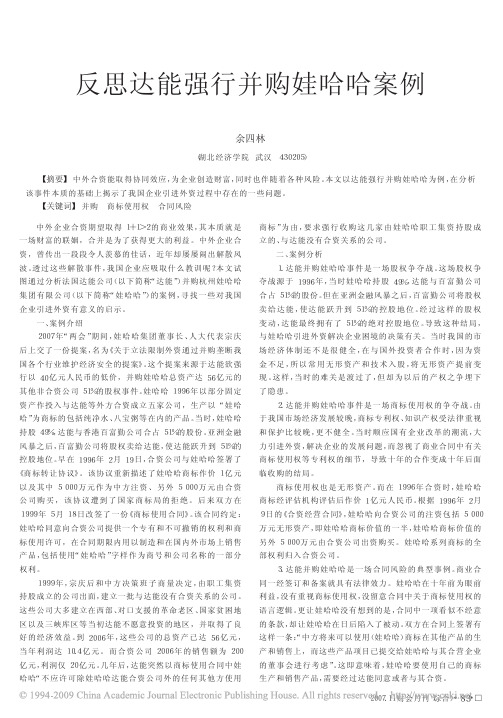
中外企业合资期望取得1+1>2的商业效果,其本质就是一场财富的联姻,合并是为了获得更大的利益。
中外企业合资,曾传出一段段令人羡慕的佳话,近年却屡屡闹出解散风波。
透过这些解散事件,我国企业应吸取什么教训呢?本文试图通过分析法国达能公司(以下简称“达能”)并购杭州娃哈哈集团有限公司(以下简称“娃哈哈”)的案例,寻找一些对我国企业引进外资有意义的启示。
一、案例介绍2007年“两会”期间,娃哈哈集团董事长、人大代表宗庆后上交了一份提案,名为《关于立法限制外资通过并购垄断我国各个行业维护经济安全的提案》。
这个提案来源于达能欲强行以40亿元人民币的低价,并购娃哈哈总资产达56亿元的其他非合资公司51%的股权事件。
娃哈哈1996年以部分固定资产作投入与达能等外方合资成立五家公司,生产以“娃哈哈”为商标的包括纯净水、八宝粥等在内的产品。
当时,娃哈哈持股49%,达能与香港百富勤公司合占51%的股份。
亚洲金融风暴之后,百富勤公司将股权卖给达能,使达能跃升到51%的控股地位。
早在1996年2月19日,合资公司与娃哈哈签署了《商标转让协议》。
该协议重新描述了娃哈哈商标作价1亿元以及其中5000万元作为中方注资、另外5000万元由合资公司购买,该协议遭到了国家商标局的拒绝。
后来双方在1999年5月18日改签了一份《商标使用合同》。
该合同约定:娃哈哈同意向合资公司提供一个专有和不可撤销的权利和商标使用许可,在合同期限内用以制造和在国内外市场上销售产品,包括使用“娃哈哈”字样作为商号和公司名称的一部分权利。
1999年,宗庆后和中方决策班子商量决定,由职工集资持股成立的公司出面,建立一批与达能没有合资关系的公司。
这些公司大多建立在西部、对口支援的革命老区、国家贫困地区以及三峡库区等当初达能不愿意投资的地区,并取得了良好的经济效益。
到2006年,这些公司的总资产已达56亿元,当年利润达10.4亿元。
而合资公司2006年的销售额为200亿元,利润仅20亿元。
达能并购娃哈哈案例分析
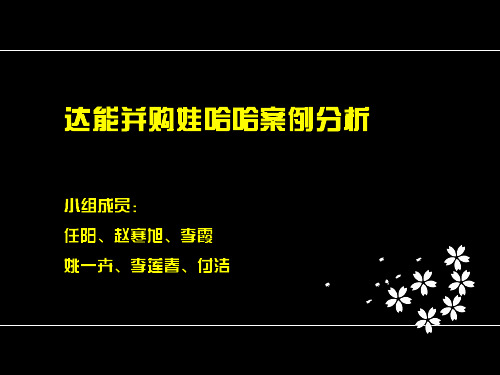
达能欲以40亿元人民币并购杭州娃哈哈集团有限公司总资产达56亿 元、2006年利润达10.4亿元的其他非合资公司51%的股权。
07
总
结
娃哈哈的胜利,不仅曝出了我们制度法律方面的 漏洞,更深层的则是我们民族意识和文化中的劣 根,还根深地存在着,并能伤及我们的根本,这 是我们每个人都应该深深长期思考的问题。
达能,尽管也在事件中扮演了非常不光彩的角色, 但是,这样一个跨国公司在中国接连投资失败, 对我们来说,则一定不是好消息。特别是在中国 经济日益国际化的今天,像达能这样的大型跨国 公司都不能在极其一般的完全竞争领域里得到中 国的认可,对中国的长远利益绝对是一种伤害。
08
Thank You For Wat影响因素
总结
02
公司简介
法国达能集团 :
欧洲第三大食品集团,九十年代初,达能集团开 杭州娃哈哈集团:
始在中国设厂,以达能为品牌的酸奶在广州及上海均 公司创建于1987年,目前为中国最大的食品饮料生 居于领导地位。 产企业,全球第五大饮料生产企业。
03
事件过程
1996年,娃哈哈与达能公司、香港百富勤公司共同出资建立5家公 司,生产以“娃哈哈”为商标的包括纯净水、八宝粥等在内的产品。
04
达能并购娃哈哈失败的原因
原因一:收购时机严重不当
1.从社会环境角度 2.从政府角度 3.从达能自身经营能力角度
4.从娃哈哈自身角度
05
达能并购娃哈哈失败的原因
原因二:收购方式不当 原因三:强硬的谈判策略严重不当 原因四:低估对手
达能强行收购娃哈哈案例分析共15页

业内有消息称,乐百氏有30%的销售人员 被裁,工厂方面裁员幅度达40%。尽管达能持 有合资公司51%股权,但整个娃哈哈集团经营 、生产的决定权都集中在宗庆后手里。在与达 能合作近10年的时间里,宗庆后凭借自身在娃 哈哈多年累计的威望、强硬的工作作风,一直
牢牢地掌控着娃哈哈的控制权。据了解,达能
曾派驻研发经理和市场总监,但都被宗庆后赶 走。
2019年,宗庆后和中方决策班子商量决定,由 职工集资持股成立的公司出面,建立一批与达能没 有合资关系的公司。这些公司建成后,取得了良好 的经济效益。
或许是良好的业绩让达能觊觎。几年后,达能突然以
商标使用合同中娃哈哈集团“不应许可除娃哈哈达能合资
公司外的任何其他方使用商标”为由,要求强行收购这几
家由娃哈哈职工集资持股成立的公司建立的、与达能没有 合资关系的公司。
三、并购结果
达能失败,娃哈哈赢得商标的使用权。
四、并购失败的反思
➢ 外资通过控股行业龙头企业从而控制整个产 业只是暂时的,靠压是压不好的,靠控制是控制 不住的,应该靠双方的融合才能实现双赢。中国 企业在国际市场上的开拓和发展同样遭到了国外 反垄断和限制外资并购法律的影响。中国应当充 分吸收和参考国外反垄断和跨国并购审查的立法 和实践经验,让《反垄断法》尽早出台;并且通 过立法,明确外资恶意并购或行业垄断的定义, 严格限定外资并购国内企业的条件。
谢谢!
法国达能公司欲强行以40亿元人民币的低价并购杭州 娃哈哈集团有限公司总资产达56亿元、2019年利润达 10.4亿元的其他非合资公司51%的股权。
1987年,宗庆后带着两名退休老师,靠着借来的14万 元起家。到了2019年,经过几番投资和收购,娃哈哈产 值突破亿元大关,已经初具规模。怀着“市场换技术”美好 愿望的宗庆后选择战略性引入世界饮料巨头达能。当时, 娃哈哈以部分固定资产作为投入与达能合资成立5家公司 。其中,达能获得合资公司51%股权。
达能强行收购娃哈哈案例分析

可编辑ppt
5
或许是良好的业绩让达能觊觎。几年后,达能突然以
商标使用合同中娃哈哈集团“不应许可除娃哈哈达能合资
公司外的任何其他方使用商标”为由,要求强行收购这几
可编辑ppt
11
➢ 通过立法设立外资并购和反垄断审查机构, 加强外资并购中的反垄断审查,对发现已有并购 中存在外资恶意并购或形成行业垄断的,采取果 断措施予以分拆或撤销、修改不合理的合同。
可编辑ppt
12
➢ 鼓励国内民营企业参与并购,特别是关系我 国国民经济命脉或国家安全的关键领域和行业骨 干企业,在保持国有经济控制力的基础上积极扶 持民营企业参与并购,防止外资恶意并购和垄断 的产生。
2000年3月,达能一举拿下乐百氏92%股权。 仅仅一年后,乐百氏原有的何伯权、杨杰强、李 宝磊等5位高层集体辞职。不仅如此,2006年, 乐百氏亏损一亿多元,其大股东达能开始大规模 展开“架构调整”。
可编辑ppt
7
据悉,在与达能合作之初,宗庆后还与达能
“约法四章”:第一,品牌不变;第二,董事长的 位置不变;第三,退休职工待遇不变;第四,45 岁以上职工不许辞退。然而,合作近10年之久, 宗庆后坦言其“市场换技术”的梦想并没有实现。 达能提供的“好处”仅是合作之初,作为收购合资 公司51%股权代价的4500万美元。这4000多万 美元对娃哈哈而言似乎也意义不大
可编辑ppt
4
其中一款称“中方将来可以使用(娃哈哈)商标在 其他产品的生产和销售上,而这些产品项目已提交 给娃哈哈与其合营企业的董事会进行考虑。”即 “提交合资公司董事会考虑”是中方使用娃哈哈商 标的前提。也正是这一条款,引发了今年的强行收 购风波。
娃哈哈与达能的纠纷
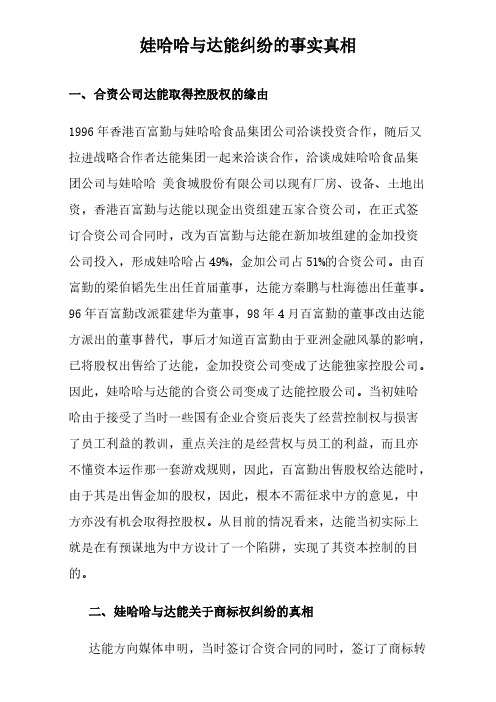
娃哈哈与达能纠纷的事实真相一、合资公司达能取得控股权的缘由1996年香港百富勤与娃哈哈食品集团公司洽谈投资合作,随后又拉进战略合作者达能集团一起来洽谈合作,洽谈成娃哈哈食品集团公司与娃哈哈美食城股份有限公司以现有厂房、设备、土地出资,香港百富勤与达能以现金出资组建五家合资公司,在正式签订合资公司合同时,改为百富勤与达能在新加坡组建的金加投资公司投入,形成娃哈哈占49%,金加公司占51%的合资公司。
由百富勤的梁伯韬先生出任首届董事,达能方秦鹏与杜海德出任董事。
96年百富勤改派霍建华为董事,98年4月百富勤的董事改由达能方派出的董事替代,事后才知道百富勤由于亚洲金融风暴的影响,已将股权出售给了达能,金加投资公司变成了达能独家控股公司。
因此,娃哈哈与达能的合资公司变成了达能控股公司。
当初娃哈哈由于接受了当时一些国有企业合资后丧失了经营控制权与损害了员工利益的教训,重点关注的是经营权与员工的利益,而且亦不懂资本运作那一套游戏规则,因此,百富勤出售股权给达能时,由于其是出售金加的股权,因此,根本不需征求中方的意见,中方亦没有机会取得控股权。
从目前的情况看来,达能当初实际上就是在有预谋地为中方设计了一个陷阱,实现了其资本控制的目的。
二、娃哈哈与达能关于商标权纠纷的真相达能方向媒体申明,当时签订合资合同的同时,签订了商标转让协议,而且是经过政府盖章同意的,因此,合资公司拥有商标的所有权,而由于在商标的有关变更权、商标所有权变更登记没有完全确定下来的情况下,签订了合资企业独家拥有娃哈哈商标使用权的使用合同。
事实上,娃哈哈确实与合资公司签订了商标转让协议,地方政府亦同意盖了章,但是地方政府盖章同意的权限是同意娃哈哈向国家商标局申请转让,而真正的审批权是属于国家商标局。
娃哈哈报批后,国家商标局从保护自己民族的驰名商标与知名品牌的角度出发,未予批准,因此,该商标转让协议并未生效。
外方也曾到商标局交涉,知道商标局没有批准以及不批准商标转让协议的原因,故其又要求签署商标使用许可合同。
达娃之争案例分析
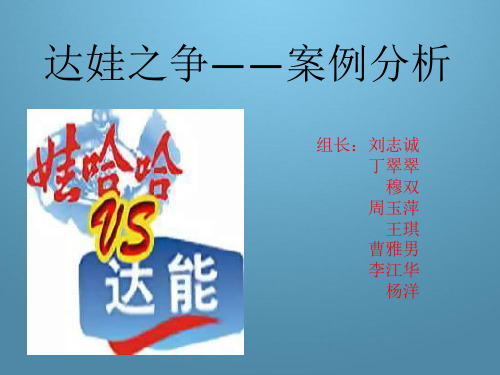
“达娃之争”结局
• 2009年9月30日,长达两年之久的“达娃之争”在一片寂静 中达成了和解,达能和娃哈哈双方联手宣布达成友好和解方 案,达能将把在各家达能-娃哈哈合资公司中的51%的股权 出售给娃哈哈,此次转让股权,达能将得到大约3亿欧元(约 4.371亿美元)的转让款,和解协议执行完毕后,双方将终止 与纠纷有关的所有法律程序 ,至此,达能、娃哈哈13年的 合作画上句号。
“达娃之争”的过程
2007年5月达娃官司
2007年5月,达能正式启动对娃哈哈的法律诉讼。同年提
起国际仲裁申请,声称娃哈哈“滥用娃哈哈标签”等问
题。 2007年12月-2008年4月达娃和谈
在两国政府协调下,双方中止了法律程序进行和谈。达能 要求以约200亿的价格将其投资在合资公司的不到14亿元 人民币股权售给娃哈哈,价格按上市公司平均市盈率计 算,被娃哈哈拒绝。
达娃之争结局2009年9月30日长达两年之久的达娃之争在一片寂静中达成了和解达能和娃哈哈双方联手宣布达成友好和解方案达能将把在各家达能娃哈哈合资公司中的51的股权出售给娃哈哈此次转让股权达能将得到大约3亿欧元约4371亿美元的转让款和解协议执行完毕后双方将终止与纠纷有关的所有法律程序至此达能娃哈哈13年的合作画上句号
爽歪歪
啤儿茶爽
红/绿茶
AD钙奶
营养快线
娃哈哈 八宝粥矿泉水 Nhomakorabea非常可乐 乳娃娃
达能集团简介
• 达能集团(Danone)世界著名的食品和饮料集团之一, 总部设立于法国巴黎,全球拥有近9万员工,是世界著 名的食品和饮料集团之一 。达能集团历史悠久,规模强 大,位列世界500强,业务遍及全世界120多个国家。鲜 乳制品、饼干和饮料作为达能的三大主要产品,在全球 市场销量排名均名列前茅。 • 达能集团创建于1966年,从九十年代起开始实施积极的 业务国际化战略,在短短近四十年的时间成为世界食品 行业的巨人,并拥有多个国际品牌,例如: DANONE (达能)、LU和EVIAN(依云)等。 • 在法国、意大利及西班牙,达能集团都是最大的食品集 团,达能亦是当今欧洲第三大食品集团,并列全球同类 行业前六名之一。
- 1、下载文档前请自行甄别文档内容的完整性,平台不提供额外的编辑、内容补充、找答案等附加服务。
- 2、"仅部分预览"的文档,不可在线预览部分如存在完整性等问题,可反馈申请退款(可完整预览的文档不适用该条件!)。
- 3、如文档侵犯您的权益,请联系客服反馈,我们会尽快为您处理(人工客服工作时间:9:00-18:30)。
国际商务合同实践报告学院:管理与经济学院专业:国际经济与贸易报告人:201314513 张婷婷201314525 彭艺茹目录一.案例介绍1.1原文介绍1.2原文翻译1.3案例概述二.案例分析三.结局反思一.案例介绍1.1原文介绍:BackgroundIf you are in China,chances are you drink at least one bottle of Wahaha brand water,or perhaps the company’s iced tea,fruit drinks,or its Future Cola.If you go to the United States,you may even come cross Future Cola in New York or Los Angeles,because the company that first set up shop in an elementary school in Hangzhou,Zhejiang,is going global.The Hangzhou Wahaha Group Co.,Ltd.,China’s leading domestic beverage producer,didn’t achieve success overnight.The company’s predecessor,the Hangzhou Shangcheng District School-Run Enterprise Sales Department,funded its start-up operations in 1987 with a government loan.Zong Qinghou,the company’s founder,and two retired schoolteachers initially sold milk products and popsicles out of a school store,but to benefit the student’s health the group soon began producing and selling nutritional drinks.The company’s success selling nutrition products in school led to its first big expansion:with Hangzhou government support,the company acquired a company then changed its name to the Hangzhou Wahaha Group Co.(The word “Wahaha”is meant to mimic the sound of a baby laughing and is taken from a children’s folk song.)Wahaha’s second large-scale expansion occurred in 1994 when the company merged with three insolvent companies in Fulling,Sichuan,to set up its first factory in Chongqing.The Wahaha Joint Venture (JV)was formed in February,1996.At the start,there were three participants in the JV:Hangzhou Wahaha Food Group(Wahaha Group),led by its chairman Zong Qinghou;Danone Group,a French corporation(Danone);and Bai Fu Qin,a Hong Kong corporation(Baifu).In 1996,the two parties signed a trademark tranfer agreement,with anintention to transfer the”Wahaha”trademark to the joint ventures.The move,however,was not approved by the State Trademark Office.For this reason,the two parties signed in 1999 the trademark licensing contract.According to law,the same subject can not be synchronously transferred and licensed the use to others by the same lost.Therefore,the signing and fulfillment of the trademark licensing contract showed that the two parties had connived the invalidation of the transfer agreement.The”Wahaha”brand should belong to the Wahaha Group,while the joint ventures only have right of use.In October,2005,the two parties inked the No.1 amendment agreement to the trademark licensing contract,in which it confirmed Party A(Hangzhou Wahaha Group Co.,Ltd.)as owner of the trademark.In addition,the second provision of the amendment agreement clearly stated that the several Wahaha subsidiaries listed in the fifth annex of the licensing contract as well as other Wahaha subsidiaries(referred to as”licensed Wahaha enterprises”)established by Party A or its affiliates following the signing of the licensing contract also have right granted by one party to use the trademark.The “licensed Wahaha enterprises”involved in the amendment agreement refer to the non-joint ventures.According to related files,Wahaha owns the ownership of the “Wahaha”trademark,while its non-joint ventures have the right to use the trademark.The Danone-Wahaha Feud--Trademark LicenseFrom May,2007 when Danone initiated legal proceeding against Wahaha,the both sides have carried out several dozen lawsuits worldwide.As of May,2009,Danone not only lost a series of cases against Zong Qinghou and the non-joint ventures in China,but directors of Danone were deemed by many courts to have violated the non-compete obligation of directors,and litigations filed in the U.S.,Italy,France and British Virgin Islands(BVI)were alsodismissed.Now,Wahaha defeats Danone 37:0 in the lawsuits in and out of China.The ownership and use right of the Wahaha trademark is one of the focuses of the”Danone-Wahaha feud.”Danone often insisted that the Wahaha trademark belonged to the joint ventures,so the use of the trademark by non-joint ventures constituted infringement.But Wahaha Group disagreed with that,and emphasized that it was the true holder of the trademark,and the use of the trademark by non-joint ventures was legal.At the beginning of the Danone-Wahaha “marriage,” Wahaha signed a transfer agreement on the ownership of the Wahaha trademark with the joint ventures,and filed a trademark transfer application with the State Trademark Office,which,however,was not approved.”It actually declared the termination of the transfer contract,and the Wahaha trademark is still owned by the Wahaha Group,”said Ye Zhijian,a lawyer who knows the case.Afterward,the two parties signed a trademark licensing contract in 1999 to substitute the original transfer agreement.Both the licensing contract and the consequent No.1 amendment agreement clarify that the non-joint ventures of Wahaha have the right to use the Wahaha trademark.“It was known to and recognized by Danone that the non-joint ventures OEM for the joint ventures,so how could it be possible for the non-joint ventures to use a different trademark from the joint ventures?”Ye noted.To confirm the ownership of the Wahaha trademark,Wahaha referred to the Hangzhou Arbitration Commission for arbitration in accordance with the trademark transfer agreement.In December,2007,the commission made a decision that the trademark transfer agreement between Danone and Wahaha had terminated,and the Wahaha trademark belonged to the Wahaha ter,the Hangzhou Intermediate People’s Court affirmed the ruling.1.2 原文翻译:背景如果你在中国,那么你至少喝一瓶娃哈哈品牌水,或者公司的冰茶,果汁饮料,或非常可乐。
